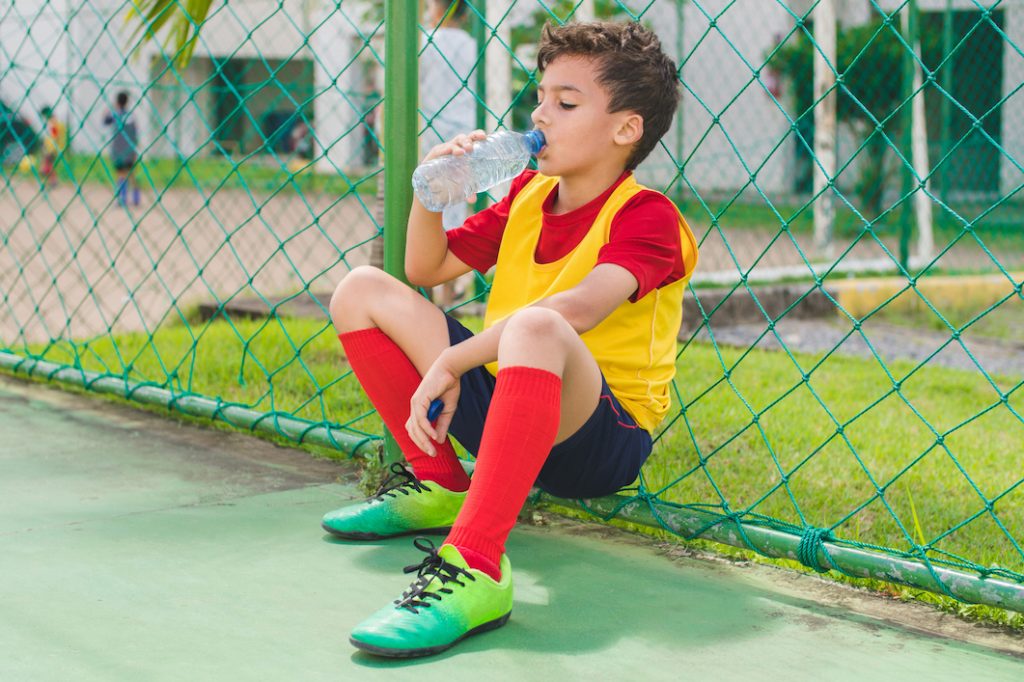If you are like me, ‘Game Day’ is a level up in the daily challenge of parenting logistics. First, I check the weather – Hot? Cold? Rainy? Windy? Humid? Then it’s time to gather the gear: appropriate team jersey and matching shorts or pants; sport-specific socks; appropriate undergarments and provisional layers for the aforementioned weather conditions. Then cleats, shin guards, ball, or, on other days, cleats, glove, hat, bats, batting gloves; sunblock. Plus, a plan to get it all where it needs to be at the appropriate time and place. Whew!
But even though I have this down to a fairly reliable system, I always pause briefly when it’s time to pack my son’s water bottle. How big should it be? What should I be putting in it? How will he remember to drink it? Appropriate sports nutrition – including appropriate hydration – is a topic that has inspired a wide range of secular and scientific opinions. It can be difficult to wade through it all so you feel confident that you are doing your best to keep your young athlete safe and at his or her best during training and competition. Here are a few practical tips:
Start Strong
Regular, daily hydration is an often-overlooked aspect of overall health as well as preparation for sports and exercise. As a general rule, you can judge whether your child is drinking enough fluids daily by observing the color of his or her first morning urine. It should be the color of lemonade or lighter; darker urine may be an indication that your child needs to drink more fluids throughout the day. If you feel confident that your child is drinking adequately and the urine is still dark-colored in the morning, you may want to check with your pediatrician as to other possible causes.
Play Hard, Play Smart
Young athletes should take rehydration breaks frequently during competition.
- In general, a brief break for rehydration every 15 – 20 minutes will meet fluid loss needs during competition. Since each gulp is about 1 oz of fluid, encourage young athletes to take five to seven gulps at each break. Teens should aim for a total of 1 – 1.5 liters of fluid intake per hour of competition.
- Young athletes should know that feeling thirsty during competition indicates that they have lost more fluids in sweat losses than they have replaced. If your child feels thirsty, he or she should stop at the first opportunity, even if that means subbing out for a period of time, to rehydrate.
- All athletes should have water readily available to them. Ideally, there will be a place to refill water bottles at the sports venue. But if this is not possible, you can estimate that your child may need 24 ounces or more of fluids for each hour of competition.
Water or Sports Drink?
- Sweat losses are primarily made up of water, sodium and chloride (sodium chloride is the chemical description of common table salt). In most children, under most conditions, the amount of water loss in sweat significantly exceeds the amount of sodium or chloride lost. This means that plain water is usually an optimal fluid for rehydration during competition.
- However, there are specific scenarios that call for the use of sports drinks instead of water:
- (1) Prolonged, intense exercise, especially exceeding two hours in duration
- (2) Hot and/or humid environmental conditions
- (3) Multi-practice or tournament scenarios, in which recovery time between periods of activity is limited
- (4) Children or adolescents who are very sweaty by nature – the amount and content of sweat being, in part, genetically determined and increasing as young athletes reach or pass puberty. An adolescent athlete participating in intense exercise in hot and humid conditions may lose as much as 2.5 liters per hour in sweat!
- When choosing a sports drink, choose one that has 14 – 19 grams (g) of carbohydrates and 110 – 240 milligrams (mg) of sodium (Na) per eight ounces. Other additives, including caffeine, are not recommended.
- If you are feeling unsure of whether your child is drinking the right amount of fluids during competition, experts recommend weighing your child (in light, dry clothing) before and after competition. A child should not lose more than 2% of their body weight during competition. He or she should never weigh more after exercise than before.
- Coaches of young athletes should be aware of and promote healthy practices. The recommendations of the American Academy of Pediatrics Council on Sports Medicine and Fitness can be accessed via the AAP website: https://pediatrics.aappublications.org/collection/council-sports-medicine-and-fitness
Know Your Limits
Young athletes should ensure that they have been properly conditioned for any intense athletic activity they are about to engage in. Concerning signs of dehydration-related illness during competition that athletes, coaches, and parents should be aware of and that should prompt immediate intervention include the following:
- Muscle cramping
- Excessive fatigue
- Very heavy breathing
- Confusion and/or headaches
- Nausea and/or vomiting
Recover and Replenish
Young athletes should continue to replenish salt and water losses after competition. Salty snacks in combination with carbohydrates – canned soups, peanut butter and other nut butters, cheese, pretzels, pizza, etc. – are often the most palatable and the best choice for the recovery phase. On-going water intake is also recommended, again targeting a light urine color to indicate the adequacy of fluid replenishment.
As a mom, I feel that ensuring that my son remains adequately hydrated and well-recovered is one of my most important contributions to his safety and success on the field. I can’t wait to do the same for my daughter in a few years! I hope this helps you to keep your own young athletes at peak performance as well – even if, like me, you occasionally can’t find just exactly the right pair of socks…






Comments